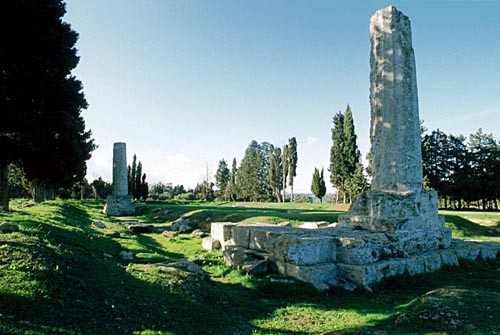Along Via Elorina, after the Roman Gymnasium and close to the Source of the River Cyane, visible from the street, stand the ruins of the Temple of Zeus, also known as the temple of the two columns, because only two columns are still standing upright.
Erected after the Temple of Apollo in Ortigia, the “Olympian” Zeus Temple is the oldest greek temple on the mainland (early sixth century B.C.). It was located in the ancient village called Polichne. The Doric building appeared impressive at that time, with six columns in the front and seventeen columns in the sides, all monolithic.
The monumentality of the area was increased by a second row of columns behind those of the facade. The cell was then preceded by a “pronaos” and followed by an áditon. The Olympeion is likely to be the most important of Syracuse, his priesthood was the first of the city and in it were contained lists of the most important citizens.
Perhaps it is also guarded the treasury of the city. Of this large structure (20,50 X 60 meters) now only two columns of the south side and a part of the “crepidoma” (the platform on which the superstructure of the building is erected) survive.
These two columns, from eighteenth century to our times, have characterized much of the views of the harbor of Syracuse. The oldest temple dates back to 491 B.C., when Hyppocrates of Gela, after defeating the Syracusans, ordered the priest not to remove the treasures because nothing would have been touched. The same respect was showed by the Athenians who camped in that zone in 414 B.C.

